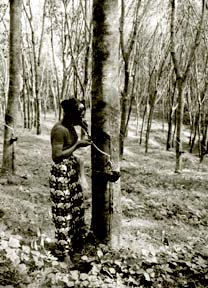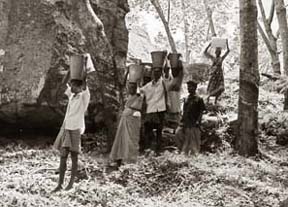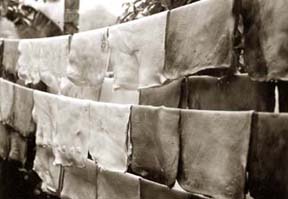|
observer |
|
|
|
|
|
OTHER LINKS |

|

|

|
A precious part of our landscape
In fact the Gardens were established in 1876 specifically for the propagation of the first seedlings of the Para rubber tree (Hevea brasiliensis) to be grown outside Brazil. How these seedlings got to the then Ceylon is a remarkable story. In 1875, a colonial agent called Henry Wickham was commissioned by the British government to supply a copious amount of Brazilian rubber seeds. Having acquired some 70,000, he then had the problem of transporting them back to England. Wickham, an enterprising man, writes in his memoirs that he found a steamer abandoned on the Amazon River, and smuggled the seeds downstream in her bales of cotton. From there they were shipped to Liverpool and brought to the Royal Botanic Gardens at Kew, in London. By June 1876, however, fewer than 4% of the seeds had germinated. In August of that year, most of the seedlings - some 2,000 - were shipped to Henaratgoda, where the moist, hot climate was not unlike that of the Amazon jungle. The trees that resulted were to give birth to the rubber industry that spread throughout Southeast Asia. In 1888, 20,000 seeds were harvested from the trees planted in Ceylon and shipped to Singapore. The first rubber plantation was established in Malaya using these seeds in 1898, and this British colony quickly became the principal source of rubber of the world's industry.
The man who first planted rubber on a commercial scale in Ceylon was the pioneer planter, Frederick Lewis, who records the event (and its lukewarm reception) in his book Sixty Four Years in Ceylon (1926): "I selected a piece of land that was on the tributary streams of the Kalu ganga river, at a place called Edangoda. I then set to work and had the jungle felled and burned off, after which I received from the famous gardens at Henaratgoda, some 3,000 selected seeds. To insure their success, I had a number of little baskets made and filled with sifted soil. Into each of these I introduced a rubber seed, and as soon as a little plant grew up to about 12 or 18 inches in height I had the whole thing planted out, basket and all, into holes that were cut in readiness to receive the precious little strangers. "The success was extraordinary. The plants grew at a remarkable rate and in a few months time had plants as many feet high as they were months old... But the natives looked on; and so did the British planter. I was freely chaffed at wasting Government money on a product that nobody was interested in.
In spite of this inauspicious beginning, within several decades rubber became one of the island's three main exports along with tea and coconut. During World War Two, Ceylon's rubber assumed vital importance for the Allies after the fall of Malaya and the loss of the crop there. Production was stepped up by tapping trees before their time or until the latex dried up, thus destroying them. A stirring account of this troubled period in the history of rubber cultivation in Ceylon can be found in Christopher Hudson's novel Colombo Heat (1986): "... He realised with a shock that what he had taken to be primal jungle was the ruins of an abandoned rubber plantation. Instead of rows of arrow-straight trees, there was a tangle of vegetation. Many of the rubber trees had fallen. Others leant at crazy angles under the weight of lianas, vines and rattans that climbed up them towards the sun. From somewhere underneath there rose a smell like rotting compost. It appalled and fascinated him, this spectacle of Nature attempting to suppress the man-made aberration of itself, like a panther biting at the bullet in its flank." Normally, trees are first tapped at from five to six years of age when the trunk attains a certain girth. The latex yields steadily increase for the next ten years, and then level out until the tree stops producing after some 35 years. Trees are tapped by the first light of day because the flow of latex eases as soon as the sun rises. Tappers use a special forked knife to shave a thin sliver of bark off the lower side of the slanting cut made on the tree trunk. Trees are tapped every second or third day, for 10 to 11 months of the year and rested in February. Rubber trees shed their leaves during this period and tapping recommences when the trees display their new foliage. The latex drains from the edge of the cut into a container fixed to the trunk, usually an environmentally friendly coconut shell cut in half. Skilful tappers (both men and women perform this work) can tap 200 to 250 trees in a morning. The collected latex looks like dirty milk when it arrives at the estate factory for processing. First it is strained through sieves and then poured into large, shallow pans for coagulation, which is speeded up with the addition of acetic acid. The latex is allowed to harden overnight. The white slabs are rolled to express moisture, and then washed, ari-dried and smoked to give protection against mould. The amber coloured sheets that result have an unmistakable smell, which is often described as being like kippers or bacon. The graceful rubber tree with its silver-barked trunk is not unlike the birch of temperate climes. As a result, rubber plantations often have a charming visual quality. The trees are planted in formal rows, and form cool green archways over the rough estate plants. Rubber is more restricted in distribution than tea, being confined to the hot and humid areas of the wet zone in the southwest region of the island below an altitude of 500 m. While a hectare of land can support 200 coconut trees, the number of rubber trees is 500. Yet there has been a steady decline in the area under rubber cultivation over the past 50 years. Nevertheless there has been an increase in production, due mainly to a replanting scheme using higher-yielding trees. Each rubber tree produces latex for 40 to 50 years and each hectare yields around 700 Kg annually. The country produces some 100 million Kg every year, of which one-third is used domestically and the rest exported. Exports of rubber amount to 6% of all export earnings. Richard Boyle |

 Rubber was first introduced to the island in 1876 at the time tea was
taking off as the new plantation crop. In August of that year, some
2,000 seedlings obtained from Brazil were shipped from London to the
Henaratgoda Botanic Gardens in the Wet Zone of Sri Lanka.
Rubber was first introduced to the island in 1876 at the time tea was
taking off as the new plantation crop. In August of that year, some
2,000 seedlings obtained from Brazil were shipped from London to the
Henaratgoda Botanic Gardens in the Wet Zone of Sri Lanka.  Near the Palm Circle in the Henaratgoda Gardens' central drive can be
found a stump labelled "No. 6" which was the first rubber tree to be
tapped in Ceylon. It was, however, "No. 2," which yielded so much white
latex that this single tree convinced those who remained sceptical of
the wisdom of establishing a rubber industry in the island.
Near the Palm Circle in the Henaratgoda Gardens' central drive can be
found a stump labelled "No. 6" which was the first rubber tree to be
tapped in Ceylon. It was, however, "No. 2," which yielded so much white
latex that this single tree convinced those who remained sceptical of
the wisdom of establishing a rubber industry in the island. 
 Nobody beyond my good and enthusiastic chief came to see my
plantations, and those who saw them by accident smiled at my waste of
time. Indeed so little did the planting community know of rubber in the
early 1890s that when I had seed to sell, nobody wanted it."
Nobody beyond my good and enthusiastic chief came to see my
plantations, and those who saw them by accident smiled at my waste of
time. Indeed so little did the planting community know of rubber in the
early 1890s that when I had seed to sell, nobody wanted it." 







